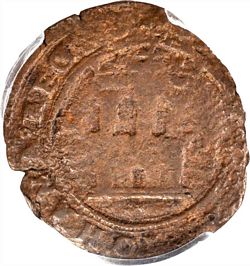Copper maravedis
by Kent Ponterio
The first copper issues were struck during the reign of Charles & Johanna. Although the mint began operating in 1536, it did not begin striking coppers that year and the very first copper coins of Mexico were produced in 1542, following a viceregal order of 28 June, under the supervision of assayer Juan Gutiérrez. This first type is what is commonly referred to as the “Early Series”, and was struck for only about one year. Only two denominations were struck for circulation in the denominations of 2 and 4 Maravedis. The “Early Series” 2 Maravedis should be considered an extreme rarity. In nearly 20 years of researching this series I have only physically seen one piece and photos of a second. Hence an “Early Series” 2 Maravedis is a true prize for a collector to own. The “Early Series” 4 Maravedis, although quite scarce, are obtainable; however, they are seldom seen in high grade. Contemporary documents such as the “Tello de Sandoval Investigation” mention that smaller denomination coppers (1 Maravedi) were struck on a trial basis, but none are known to exist today.


KM-2; Nesmith-Plate-XII#1; Cal-unlisted type. Early Series. 4 Maravedis. (Stack’s Bowers Baltimore Auction, Winter 2014, lot 391)
The second type of coppers issued under Charles & Johanna began production in 1542 when new equipment arrived from Spain. These are referred to as the “Late Series” and were only produced until 1543. Much like the “Early Series”, these are only found in the denominations of 2 Maravedis and 4 Maravedis. The “Late Series” 4 Maravedis are slightly scarce, yet rare in high grade, and the 2 Maravedis are rare.


KM-1.3; Cal-type-133#206;. Late Series 2 Maravedis, (Stack’s Bowers Baltimore Auction, November 2015, lot 39317)


KM-3.3; Nesmith-7; Cal-type-135#203c Late Series 4 Maravedis (Stack’s Bowers Baltimore Auction, November 2015, lot 39318)
On 6 March 1550, the Cabildo of Mexico City asked the Viceroy Mendoza to give the order to stop the manufacture of these coins since it caused arrogance, greed and laziness among the natives.
